India is a land steeped in culture and traditions. It therefore comes as no surprise that marriages in India are marked by a lot of customs and traditions that are religiously followed to this day. The Wedding Traditions in India are an impressive manifestation of the rich cultural heritage of the country. Interestingly this country is known as much for its unity as for its diversity and this variety is implicit in the Wedding Traditions in India as well.
Different regions of India follow different customs and each of these customs hold a special meaning and significance. There are some thought that are common and the underlying intention of all these customs is the well being of the couple, their happiness, harmony and prosperity.
Some typical Indian wedding include the Hindu wedding, Punjabi wedding, Indian Muslim wedding, and Christian wedding. In India every part has their own type of wedding ceremony and totally diverse customs and cultural connotations can flummox anybody.
Different types of Indian Weddings are-
Hindu Wedding
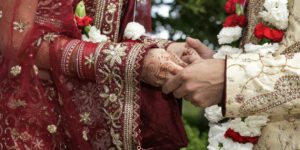
Hindu Wedding takes place with rituals like Jaimala, Kanyadaan, Sindoor, Mangalphere and Saptapadi. These are held at night with a ‘pandit‘ or priest who takes care of religious rituals and chants Sanskrit hymns and mantras in front of the sacred fire. Shahnai is played throughout the functions in the background. The groom arrives for the wedding along with his ‘baraat‘ dancing all the way. The groom is either in a car or on the horse back!
The most important ritual in Hindu marriages is Saptapadi when the bride and the groom have to take seven steps together facing the North direction after which the bride shifts to the groom’s left. Now, the couple is declared as married! All weddings culminate with Doli or farewell of the bride to the groom’s house.
Sikh Wedding
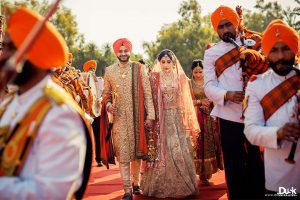
In a Sikh wedding, bangle ceremony is really a unique event when the bride’s maternal uncle and aunt put red bangles on the bride’s wrist. Also, during the marriage ceremony, the bride and the groom sit in front of the Granth Sahib. The prayers (ardas) are read out and the ten Sikh gurus are saluted.
Bengali Wedding
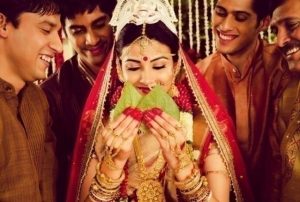
Bengali wedding too has similar traditions with different names. Main rituals include Vridhi puja (when ancestors of the bride and groom are remembered), Gae Halud Tattva ritual (in which bride is given gifts by in-laws) and Snan ritual (turmeric and oil are applied to the couple). Wedding day rituals include welcoming of the groom, Shubho Drishti ritual (when bride and groom see each other for the first time), mala Badal ceremony (exchange of garlands), Saat Paak (bride is made to sit on a wooden plank and lifted by her brothers) and Saptapadi. Post wedding rituals comprise of Basar Ghar ceremony (newlyweds are served delicious food), Bashi Biye ritual (groom applies vermilion on bride’s forehead), Bidaai ceremony, Bou Baran (welcome ceremony for bride at the groom’s house) and Bou Bhat ceremony (bride eats her first meal in her husband’s house).
Muslim Wedding

Muslim marriage is a contract between two individuals. Mangni takes place when the couple exchange rings and the marriage date is fixed. Mehendi ceremony is the time for decoration of palms and feet using mehandi. Wedding day is filled with enthusiasm as the groom arrives with a musical band. The groom drinks sherbat with the bridegroom’s brother and then the Nikah takes place in the presence of the priest (maulvi) who reads important verses from the Quran. The ritual of Ijab-e-Qubul (proposal and acceptance) takes place. The groom sends proposal to the bride and marriage is solemnized only after the consent of the girl. Nikahnama is a document wherein the marriage contract is registered.
Christian Wedding

Christian wedding is organized in a Church and the best man (someone close to the groom) greets the bride with a bouquet! The bride’s father accompanies her to the altar and after reading out of verses from the Bible, in the presence of two witnesses, the groom and bride are declared as husband and wife. The groom repeats wedding vows. Rings are exchanged between the couple. Both are blessed by the priest and they walk the aisle together. Everyone joins for a feast along with cutting of the wedding cake. All present raise a toast in the name of the newlywed couple!
Buddhist Wedding
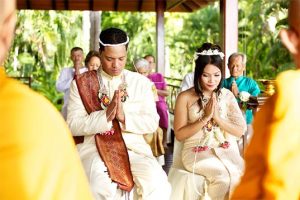
Like the religion, Buddhist Weddings are deeply spiritual affairs where emphasis is more on realization of the vows than strict religious practices. Devoid of any pomp and show, Buddhist weddings are starkly different than weddings in any other cultures in India. There are no strict set of ritualistic guidelines to be followed during a Buddhist weddings from their scriptures as marriage is generally not seen as a path for salvation by Lord Buddha. They are considered to be a personal choice and not a religious duty, like in Hinduism. Buddhist families have full freedom to decide what sort of wedding ceremony they want. Inclusions of Lamas or Buddhist monks are not mandatory to solemnize the wedding although legal registration of the marriage is given importance.
Jain Wedding
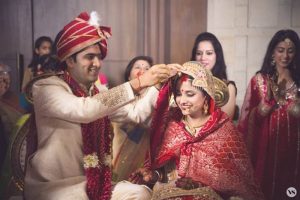
Pre wedding rituals among Jains include Lagana Lekhan which is organized at the bride’s house. Vinayakyantra puja and Sagai are held at the groom’s place. The date and time for the wedding is agreed upon in Lagana Lekhan ceremony. The letter is read out aloud in the groom’s house during Lagna Patrika Vachan. Other rituals are Mada Mandap, Barati, Aarti, singing of mangal geet etc. On the day of the wedding, the bride and groom sit in the mandap and rituals like kanyadaan (or kanyavaran), Granthi Bandhan (tying of knot of sari with groom’s shawl), mangal pheras, seven vows taken by couple, exchange of garlands, havan, Shantipath and Visarjan. After the wedding, the couple is blessed by everyone (Ashirwaadceremony). The bride is welcomed in the groom’s house (Sva Graha Aagamana). Alms are distributed in Jain temple and this is called as Jina Grahe Dhan Arpana. The couple is formally introduced to everyone in the reception hosted by groom’s family.
Assamese Wedding
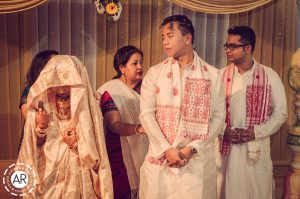
In Assam, wedding ceremony is known as ‘Biya‘. The Juran ceremony involves visit of groom’s mother to the bride’s house. During Tel Diya ceremony, the groom’s mother applies sindoor and gifts traditional Assamese dress mekhla chadar. During the wedding, the groom wears dhoti, kurta and silk shawl. The blowing of the conch shells during wedding ceremony imparts a spiritual atmosphere.
Gujarati Wedding
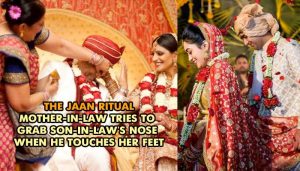
Mangal Mahurat involves praying to Lord Ganesha for His blessings. Other rituals include Jaan (to ward off evil). Imagine the scene when the groom touches his mother-in-law’s feet and she tries to clutch his nose! Well, some rituals are meant to amuse and bring cheer in the family. Wedding day comprises of Jaimala (exchange of garlands between the couple), Madhuparka (washing of groom’s feet and offering him milk and honey to drink), Juta Churai (when bride’s sisters try to steal the groom’s shoes and give them back only after much cajoling and gifts in return!), Kanyadaan (bride’s father washes the groom’s feet and gives the hand of his daughter for marriage) and Hasta Milap (groom’s shawl is tied to the bride’s saree). Mangalpheras takes place amidst chanting of hymns by priest and the couple takes rounds (pheras) around the sacred fire. They are blessed by everyone present. Post wedding rituals are Vidai ceremony (bride leaves her home), Ghar Ni Lakshmi (when bride reaches groom’s home and is asked to knock down vessel filled with rice), Aeki Beki (in which water is coloured using sindoor and milk and coins and ring are put into it which the bride and groom have to find).
